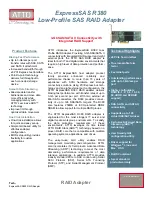
SUGGESTED MIC TYPES
Stick-type cardioid condenser mic
For miking cymbals and acoustic instruments, get a small-diaphragm, cardioid or supercardioid
condenser microphone with a flat frequency response. This is a stick-shaped microphone, usually
end-addressed, with a diaphragm under 1 inch in diameter (Figure 2, bottom).
Figure 2. Cutaway view of a cardioid dynamic mic (top) and a cardioid condenser mic (bottom).
Let’s explain the tech terms. Briefly, a
cardioid
microphone rejects sound from the rear and
reduces pickup of room reverberation. It helps reject sounds from instruments you don’t want to
pick up. A
condenser
microphone uses a lightweight diaphragm charged with static electricity.
When sound waves vibrate the diaphragm, the microphone generates a signal. A condenser mic
generally gives a clear, detailed sound. It needs a power supply to operate, such as a battery or
phantom power supply. Many mixers have phantom power built in. A flat frequency response
indicates that the microphone reproduces the tone quality of the voice or instrument with high
fidelity.
Some examples of low-cost condenser mics for instruments are: Crown CM-700 (Figure 3) and
AKG Perception 170.
























